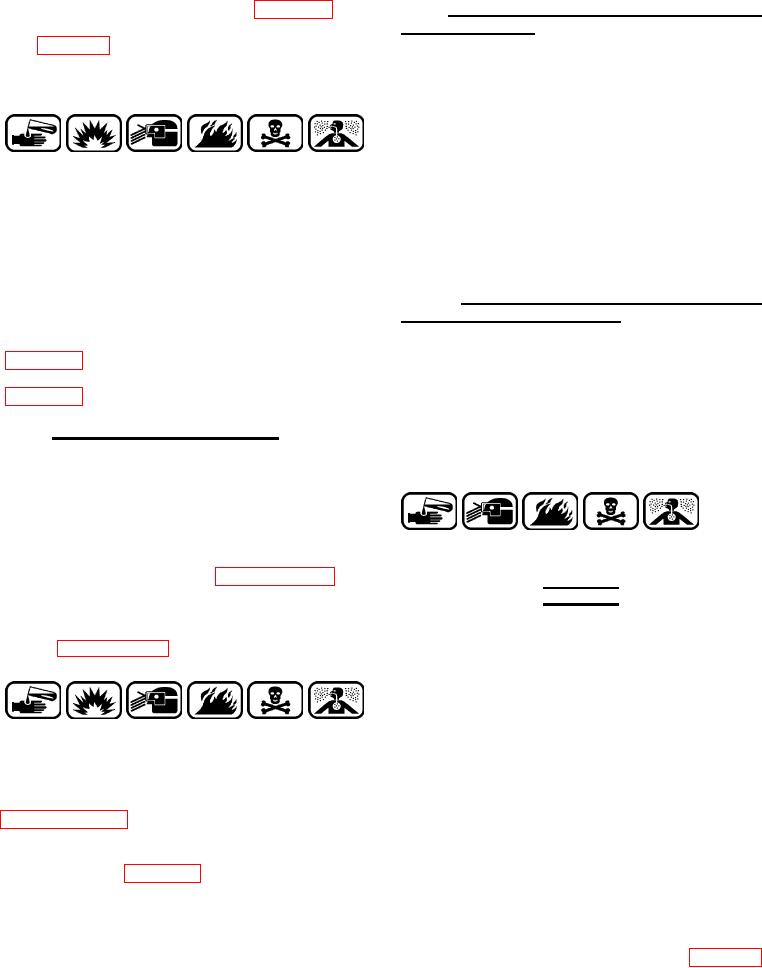
01 March 2005
NAVAIR 01-1A-509-3
TM 1-1500-344-23-3
TO 1-1-689-3
MIL-DTL-81706. (Volume IV or V, Chapter 2), and
6-2.4. BATTERY COMPARTMENTS, BOXES, AND
painted in accordance with Volume II (Navy and Army)
ADJACENT AREAS. The battery, battery cover, battery
and Chapter 5. Air Force personnel should refer to
box, and adjacent areas (especially areas below the
equipment specific manuals for proper color and paint
battery compartment) are subject to the corrosive
systems.
action of the electrolyte. Two different types of batteries
are encountered on avionic equipment, lead acid type
(sulfuric acid electrolyte) and nickel-cadmium type
(potassium hydroxide electrolyte).
Compound, Corrosion Preventive
3
NOTE
Water-Displacing
MIL-C-81309
Refer to NAVAIR 17-15BAD-1 (Navy) or
TM 11-614S203-14-2 (Army) for additional
Compound, Corrosion Preventive 26
i n f o r m a t i o n on maintenance of aircraft
MIL-DTL-85054
batteries.
f. When environmental conditions or time do not
6-2.4.1. Preparation of Solutions for Cleaning and
permit other surface treatment, preserve with a thin
Neutralizing Battery Electrolytes. Indicating solutions
film of Water Displacing Corrosion Preventive
are required for cleaning areas subjected to electrolyte
Compound, MIL-C-81309 Type II (Volume IV or V,
spills. These solutions determine the location of
Chapter 2) or Corrosion Preventive Compound,
contaminated areas and indicate when these areas
MIL-DTL-85054 Clear (Amlguard) (Volume IV or V,
have been completely neutralized. Use a 10% sodium
bicarbonate (ordinary baking soda in water) solution to
neutralize sulfuric acid from lead acid batteries and a
6-2.3. E N G I N E COMPARTMENTS.
Remove
3% boric acid (in water) solution to neutralize potassium
corrosion and preserve as follows:
hydroxide from nickelcadmium batteries.
a. Inspect the compartment, hardware, electrical
connectors, terminal boards, junction boxes, and ram
air turbine for signs of salt spray contamination and
corrosion.
Alcohol, Isopropyl
6
TT-I-735
b. Treat in accordance with paragraph 6-2.2. with
the following exceptions.
WARNING
(1) Treat electrical connectors in accordance
Sulfuric acid and battery electrolytes are highly
with paragraphs 6-3.11. through 6-3.11.4.
toxic to eyes, skin, and respiratory tract. Avoid
all contact. Skin and eye protection is required.
If any acid/ electrolyte contacts the skin or
eyes, flood the affected area immediately with
water and consult the Base Medical Service.
Compound, Corrosion Preventive
3
Emergency shower and eye wash station are
Water-Displacing
required. Use only with adequate ventilation.
MIL-C-81309
Assure this operation has been reviewed by
local Bioenvironmental Engineer.
(2) Treat terminal boards in accordance with
paragraph 6-2.8. Preserve internal surfaces and
When working around batteries, always wear
terminals with a thin film of Water Displacing Corrosion
eye protection (face shield), acid resistant
P r e v e n t i v e Compound, MIL-C-81309 Type III
rubber apron and gloves.
(Volume IV or V, Chapter 2).
6-2.4.1.1. Litmus Indicating Solution. Litmus indicating
(3) Treat ram air turbine in accordance with the
solutions are used on lead acid battery electrolyte
applicable service directives.
spills. Make one pint of a mixture containing 70%
Isopropyl Alcohol, TT-I-735 (Volume IV or V, Chapter 2)
6-2

